Rounded Corners on Customs
ROUNDED CORNERS ON CUSTOMS
Molded body lines, fine tuned with rounded corners on the hood, doors and trunk make a Custom really smooth. When did this trend started?
Rounded corners on Custom Cars is something that I always thought had been done since the very early beginnings of Customizing. The rounded corners fit so well on the smooth look of many customs. But in fact rounding door, hood and trunk corners is something that started at a later date several years after chopping tops became a “standard”. Like with most things in the early history of the Custom Cars, there is not much written down, or documented very well. So it is very hard to tell when exactly the first top was chopped, the first grille was narrowed or when the first corners where rounded to make a car look better, more streamlined, more exclusive.
It was not until I did my research on the Jack Stewart 1941 Ford that I realized that rounding the corners on custom cars started to get really popular until around 1950-51. And I have to say that that kind of made me wonder about this. Especially since the popular car to Customize, the 39-40 Mercury coupes and convertibles came with factory rounded corners in 1939 and 1940. Everybody could see how the rounded top trunk corners on these cars looked so good, and make everything flow really nice. The Ford cars of the same year, and both cars after 1940 never had the trunk corners rounded from the factory. That would have made the cars more expensive, more metal was needed to stamp those, plus the dies would have been more complex.
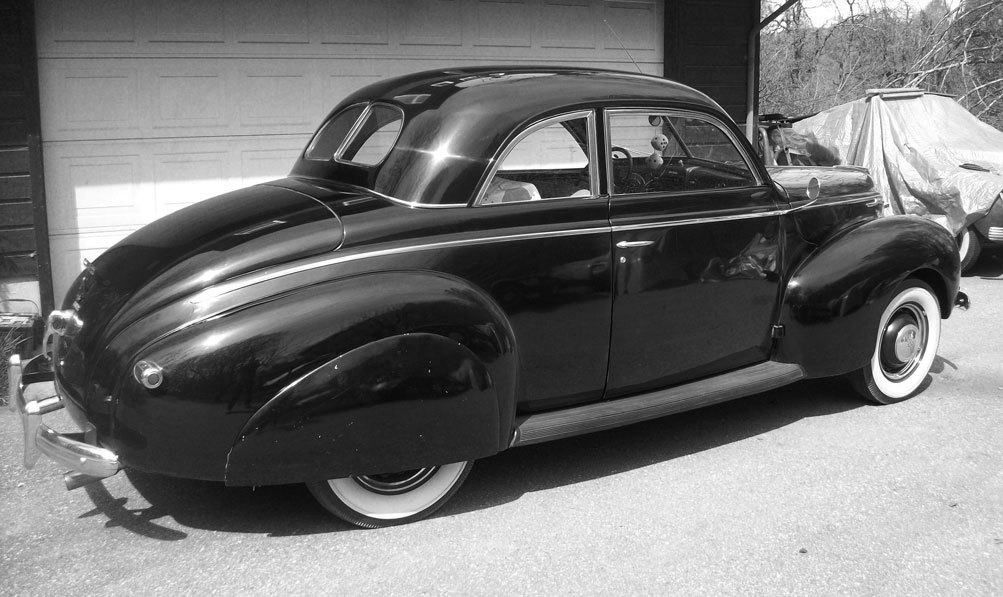 The 1939 Mercury came with factory rounded top trunk corners, which looked really stunning on the car. The ’40 Mercury convertible and coupe still had the same rounded corners, and but for the all new ’41 models this feature was deleted from the design.
The 1939 Mercury came with factory rounded top trunk corners, which looked really stunning on the car. The ’40 Mercury convertible and coupe still had the same rounded corners, and but for the all new ’41 models this feature was deleted from the design.
[divider]
 The ’36 Ford 3-window coupe has a nice round shape on the door tops. The 5-window coupe (as well as the sedans) had a square top corner. Although the top corners on the 36 Fords rarely get rounded due to the body lines around the window openings, I think that the shape of the 3-window coupe doors (and similar styled cars) has played a roll in the rounding of door corners on customs.
The ’36 Ford 3-window coupe has a nice round shape on the door tops. The 5-window coupe (as well as the sedans) had a square top corner. Although the top corners on the 36 Fords rarely get rounded due to the body lines around the window openings, I think that the shape of the 3-window coupe doors (and similar styled cars) has played a roll in the rounding of door corners on customs.
[divider]
From my research I came to the conclusion that the rounding of corners on custom cars started around the mid 1940’s. In the early years not all the corners were rounded like we know from more recent built customs. The rounded corners started on California Custom Cars with metal tops, sedan’s or 5-window coupes that were chopped and had the drip rails shaved. The new smooth top shape looked really great and made the car flow much nicer than with the drip rails and stock height tops. But the square top corner of the doors interfered with the flow.
This problem was not evident on the 3-window coupe models, like the 35′-35 Fords. These cars had nice rounded door top frames, flowing nice with the rear of the tops. Even after chopping these 3-window coupes the flow looked good, and was even better. To make the sedan and 5-window coups look better after the top had been chopped and the drip rails had been shaved they started to round the door top corners, and make then flow much better with the new top shape.
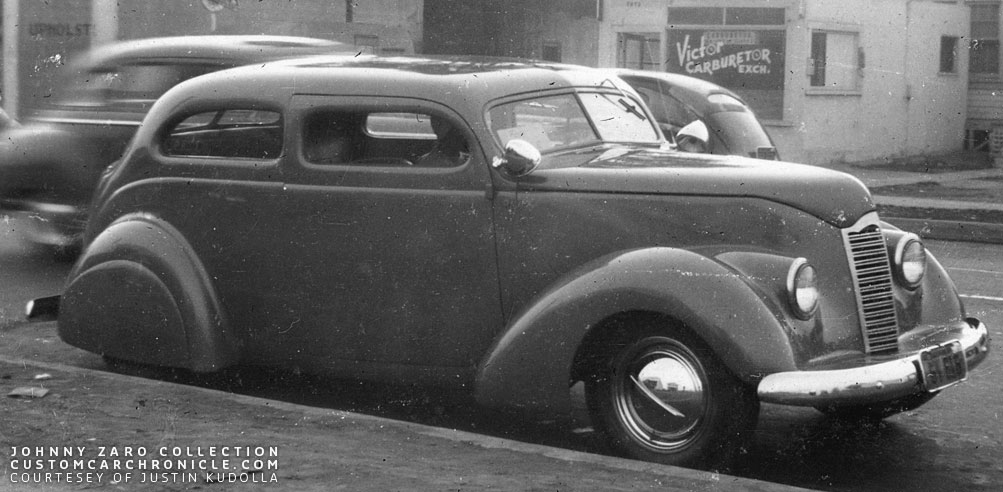 Chopped 1938 Ford Sedan at the Barris Compton Ave shop around 1948 shows shaved drip rails, molded fenders and a small radius rounded door top corner.
Chopped 1938 Ford Sedan at the Barris Compton Ave shop around 1948 shows shaved drip rails, molded fenders and a small radius rounded door top corner.
[divider]
 The dick Fowler 1938 Ford Coupe was created in 1946-47. the Barris shop shaved the drip rails, and to make the doors flow better with the new roof shape they rounded the rear corners. Almost in a similar way to that on the ’35-36 Ford three window coupes.
The dick Fowler 1938 Ford Coupe was created in 1946-47. the Barris shop shaved the drip rails, and to make the doors flow better with the new roof shape they rounded the rear corners. Almost in a similar way to that on the ’35-36 Ford three window coupes.
[divider]
 Top photo was taken most likely in the mid 1940’s It shows an early version of the Bob Creasman 1940 Ford coupe with chopped top and filled quarter windows. The car still has the front section of the drip rail, which ends shortly behind the door top corner. The door top corner is not rounded (from the Carl Johnson collection). The bottom photo was taken in 1947 (Bart Bartoni Collection) of another 40 Ford with a similar chop and 3-window treatment. On this car the drip rails have been completely removed and the top door corners are rounded, to make the door line flow better with the shape of the top.
Top photo was taken most likely in the mid 1940’s It shows an early version of the Bob Creasman 1940 Ford coupe with chopped top and filled quarter windows. The car still has the front section of the drip rail, which ends shortly behind the door top corner. The door top corner is not rounded (from the Carl Johnson collection). The bottom photo was taken in 1947 (Bart Bartoni Collection) of another 40 Ford with a similar chop and 3-window treatment. On this car the drip rails have been completely removed and the top door corners are rounded, to make the door line flow better with the shape of the top.
[divider]
In the early days when the corners were rounded, this was pure an optical modification. The original square corner was cut to a nice radius, then a filler piece was hand shaped and welded to the body, smoothed and painted. The original square rain cutters inside the trunk remained factory stock. In the last few decades the need for more finished work has been developed, and now-days when corners are rounded the original cutters inside are reshaped to match the new corners, to make the whole modification like how it came from the Factory, perhaps even better than that.
One other inspiration source for the rounded corners on Customs might have come from the Pick Up Truck. Pick Up Truck cabins in the 1930’s were very square, for obvious reasons. And in the early 1930’s the door corners were, just as on the passenger cars, mostly square. But from 1935 the corners on the doors of these truck were often rounded giving the square cabins a nicer and softer, more designed look. Perhaps this was potted by some of the pioneer Customizers. (Thanks to Ian Cross for pointing this out)
41-48 Ford – Mercury rounded corners
Some of the famous all smooth custom cars from the 1940’s surprisingly did not have rounded trunk corners.
The rounding of trunk and hood corners on customs started a few years later, around 1950. It was somewhere in 1950 when Jack Stewart took his unfinished Ayala built ’41 Ford to George Barris to finish. The Ayala’s had done most of the work on the car, including full fade-aways and rounding the door top corners after the top had been chopped, and the drip rails shaved. But all the corners on the hand made hood and the trunk were still unmodified with square corners. One of the things George did on this car was rounding all the corners in such a way that everything flows much nicer with the rest of the molded in body. I’m not sure if this was the first car that had all the corners rounded, but it sure if one of the first.
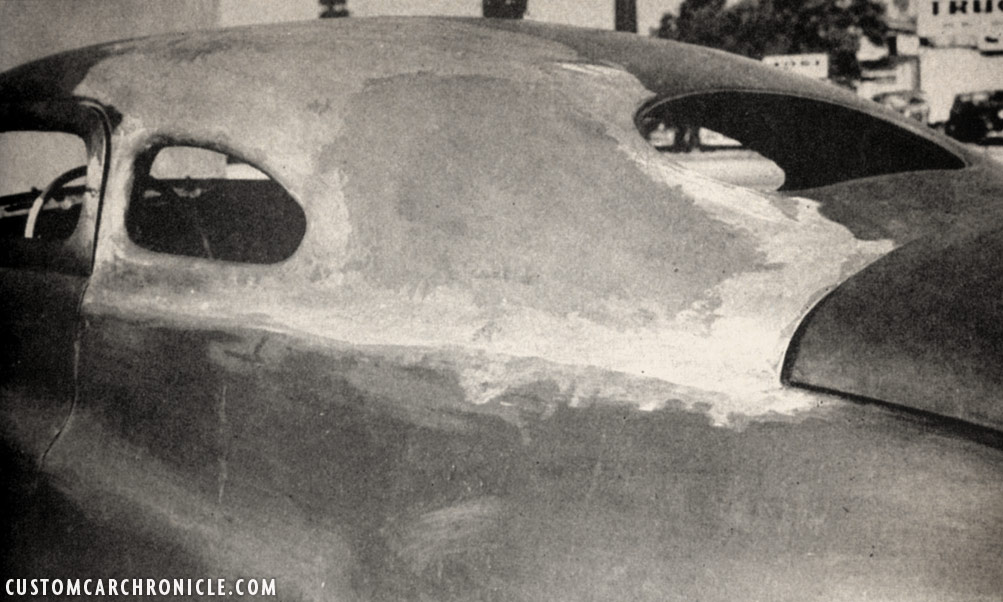 This photo was taken early 1950 of the Jack Stewart 1941 Ford coupe at the Ayala shop. The roof had been re-chopped and full fade away fenders added to the channeled body. But as this photo shows the trunk corners are still square.
This photo was taken early 1950 of the Jack Stewart 1941 Ford coupe at the Ayala shop. The roof had been re-chopped and full fade away fenders added to the channeled body. But as this photo shows the trunk corners are still square.
[divider]
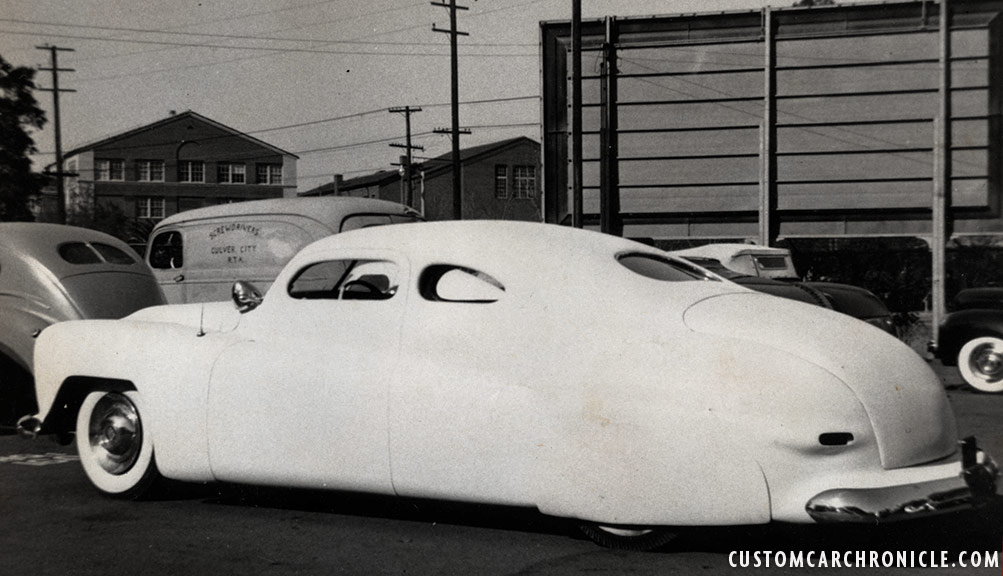 Later in 1950 George Barris took over the work on Jack Stewart’s 1941 Ford and id all the finishing body work including all rounded corners. The car was finished in white primer for the 1950 Balboa Easter weekend party.
Later in 1950 George Barris took over the work on Jack Stewart’s 1941 Ford and id all the finishing body work including all rounded corners. The car was finished in white primer for the 1950 Balboa Easter weekend party.
[divider]
 In all the old photos the rounded corners on Jack’s Ford look really great, but when Palle Johansen bought the Ford and started its restoration we were able to take a closer look at the work. The rounding of the corners was done rather crude, it looked great from the outside, but once the trunk and hood were opened it showed that the work was done only cosmetic, typical for a lot of work on the customs cars in the early 1950’s.
In all the old photos the rounded corners on Jack’s Ford look really great, but when Palle Johansen bought the Ford and started its restoration we were able to take a closer look at the work. The rounding of the corners was done rather crude, it looked great from the outside, but once the trunk and hood were opened it showed that the work was done only cosmetic, typical for a lot of work on the customs cars in the early 1950’s.
[divider]
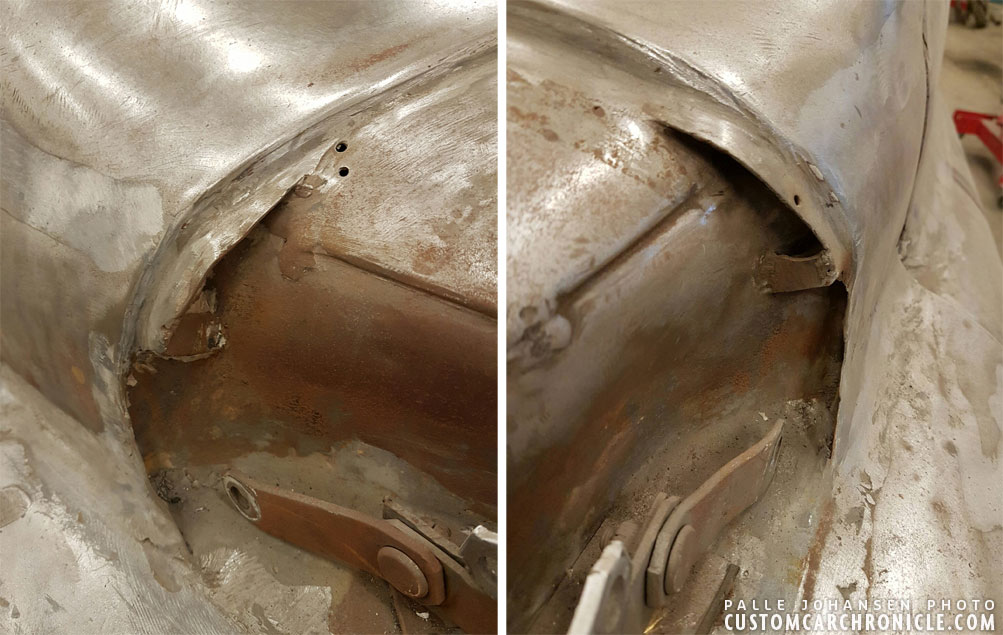 The rear corners of the hood and cowl were also rounded. The bare metal photos show how “primitive” and “crude” this modification was done. But with the hood closed, nobody would ever know.
The rear corners of the hood and cowl were also rounded. The bare metal photos show how “primitive” and “crude” this modification was done. But with the hood closed, nobody would ever know.
[divider]
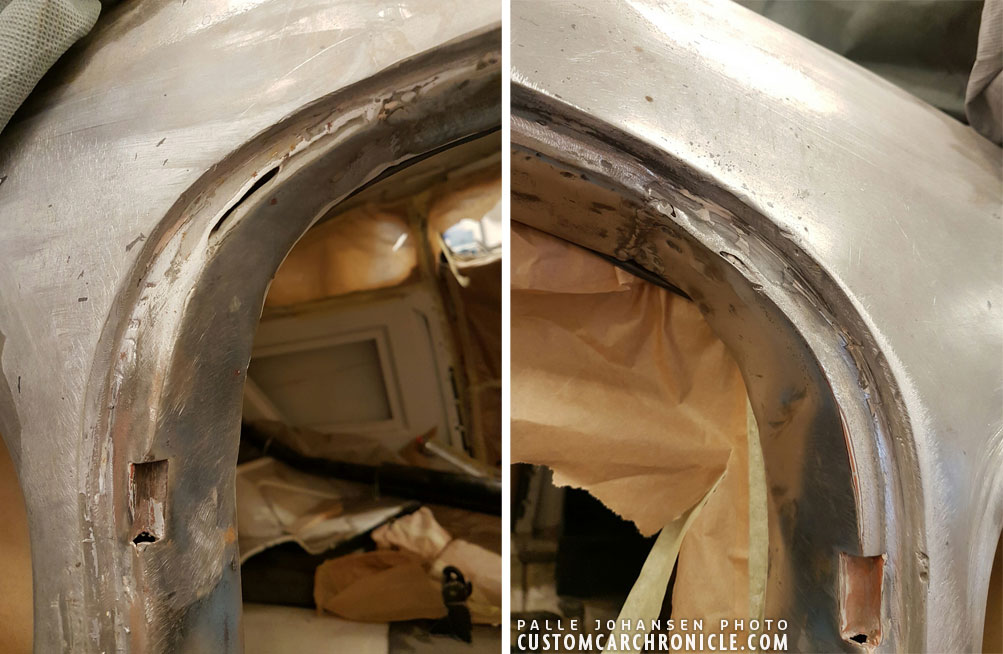 The work done on the door tops was done nicer than the trunk and hood corners. Obviously this work would how considerably more than the other corners. These bare metal photos show that lead filler and heavy paint hided the rough body work.
The work done on the door tops was done nicer than the trunk and hood corners. Obviously this work would how considerably more than the other corners. These bare metal photos show that lead filler and heavy paint hided the rough body work.
[divider]
 The flowing lines accentuated by the rounded corners on the Jack Stewart Ford photographed in 1951.
The flowing lines accentuated by the rounded corners on the Jack Stewart Ford photographed in 1951.
[divider]
Rounding corners helps with the flow of the lines on a custom car. In case of Custom cars with a lot of body panels molded in and smoothed, like the Jack Stewart Ford and the Louis Bettancourt Mercury, any sharp corner distracts from the overall flow. The rounded corners are much easier on the eyes, and often help with the flow of the top into the cowl and trunk era of the cars.
I’m not sure if the decision from FoMoCo to not ad rounded corners to the 1941 and up Mercury’s (as well as the Ford models) was a financial reason, or something else. The rounded top trunk corners on the ’39 and ’40 Mercury’s must have cost more metal, larger dies, and overall higher production costs.
 One of those famous Customs that perhaps should have had rounded trunk corners is the Jesse Lopez 1941 Ford. Created in 1947-48 by Jesse and Sam Barris it never had rounded corners, even though every other body panel had been molded and smoothed.
One of those famous Customs that perhaps should have had rounded trunk corners is the Jesse Lopez 1941 Ford. Created in 1947-48 by Jesse and Sam Barris it never had rounded corners, even though every other body panel had been molded and smoothed.
[divider]
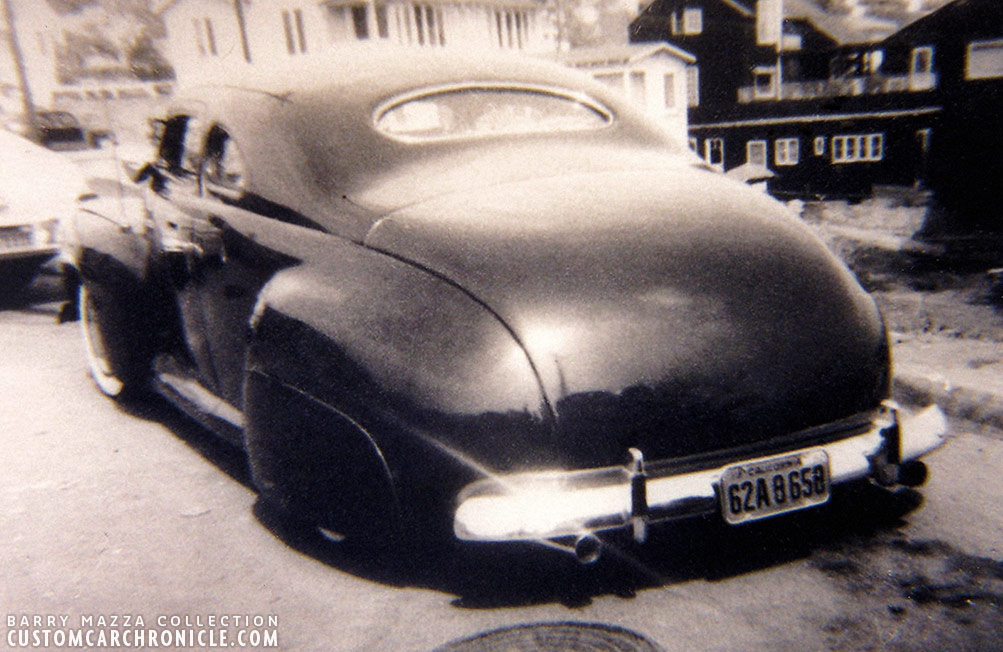 Barris created the “Snooky” Janich Ford around 1948-49, and at the time the door tops were rounded, but the trunk top corners were still straight, as how they came from the factory, as this 1949 photo shows.
Barris created the “Snooky” Janich Ford around 1948-49, and at the time the door tops were rounded, but the trunk top corners were still straight, as how they came from the factory, as this 1949 photo shows.
[divider]
 This photo of the Snooky Janich Ford was taken at the Barris Atlantic Blvd shop around 1951, by then the trunk top corners have been rounded.
This photo of the Snooky Janich Ford was taken at the Barris Atlantic Blvd shop around 1951, by then the trunk top corners have been rounded.
[divider]
 The work on the rounded corners on the Snooky Janich Ford looks similar to the work done on the Jack Stewart Ford, kind of rough, but looking good from the outside.
The work on the rounded corners on the Snooky Janich Ford looks similar to the work done on the Jack Stewart Ford, kind of rough, but looking good from the outside.
[divider]
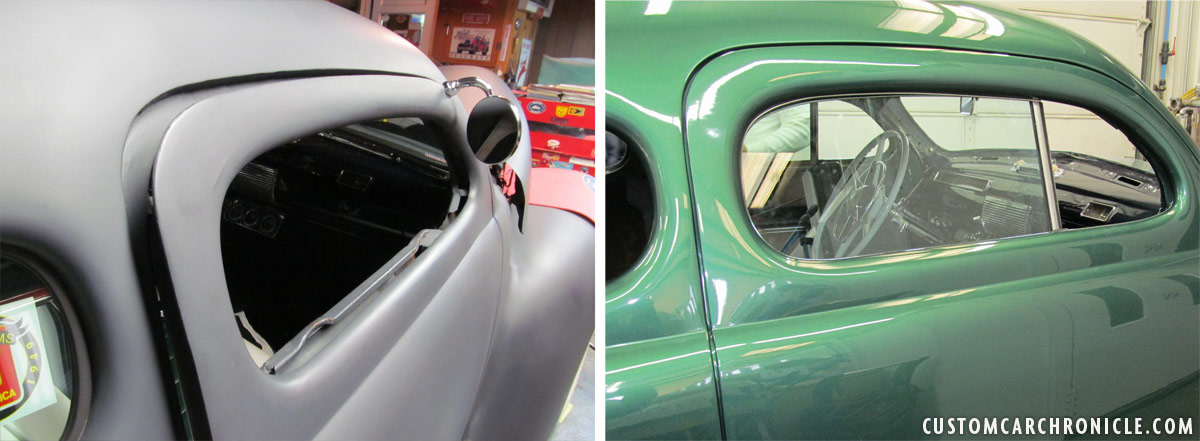 The door top corners of Snooky’s Ford were rounded when the top was chopped the first time around. With the drip rails shaved a factory stock square corner would have looked totally out of place here. During restoration it became evident that the work looked good with the doors closed, but the inside needed work to look more finished.
The door top corners of Snooky’s Ford were rounded when the top was chopped the first time around. With the drip rails shaved a factory stock square corner would have looked totally out of place here. During restoration it became evident that the work looked good with the doors closed, but the inside needed work to look more finished.
[divider]
 Marcia Campbell’s 1942 Ford was built by the Barris shop around 1949, and finished in 1950. Everything molded in, shaved drip rails, rounded, with large radius door top corners, but square trunk corners. The color photo was taken in 1950. Later the car was owned by Ann DeValle and repainted Sierra Gold (top photo), the trunk corners were not changed.
Marcia Campbell’s 1942 Ford was built by the Barris shop around 1949, and finished in 1950. Everything molded in, shaved drip rails, rounded, with large radius door top corners, but square trunk corners. The color photo was taken in 1950. Later the car was owned by Ann DeValle and repainted Sierra Gold (top photo), the trunk corners were not changed.
[divider]
 Bill DeCarr’s 1941 Mercury is another sample of the super smooth all molded in look. The car was created at the Barris Compton Ave shop around 1948-49. Even though everything is molded in, the drip rails shaved and the door top rounded, the trunk corner remain stock.
Bill DeCarr’s 1941 Mercury is another sample of the super smooth all molded in look. The car was created at the Barris Compton Ave shop around 1948-49. Even though everything is molded in, the drip rails shaved and the door top rounded, the trunk corner remain stock.
[divider]
 Jack Brumbach’s 1942 Ford was most likely done around 1950-51. The October 1951 issue of Popular Science showed some in progress photos of this car, and the finished car was showed at the 1952 Petersen Motorama. The car had rounded door corners with shaved drip rails, but the trunk corners were not rounded. (This photo was taken a little later after the car had the rear raised and skirts removed.)
Jack Brumbach’s 1942 Ford was most likely done around 1950-51. The October 1951 issue of Popular Science showed some in progress photos of this car, and the finished car was showed at the 1952 Petersen Motorama. The car had rounded door corners with shaved drip rails, but the trunk corners were not rounded. (This photo was taken a little later after the car had the rear raised and skirts removed.)
[divider]
 The Wally Welch 1941 Ford is getting the fenders molded in at Gil Ayala’s Auto Body works. The license plate tag reads 1950. While the new body mods will smooth out the complete body lines the the trunk corners are not rounded, which would have helped the flow even more.
The Wally Welch 1941 Ford is getting the fenders molded in at Gil Ayala’s Auto Body works. The license plate tag reads 1950. While the new body mods will smooth out the complete body lines the the trunk corners are not rounded, which would have helped the flow even more.
[divider]
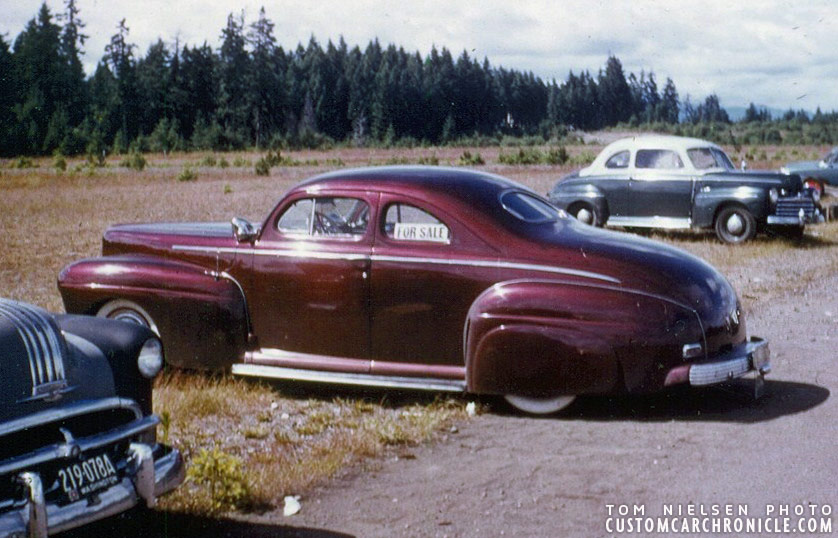 Bob Tormey’s 1941 Mercury shor door coupe was chopped and restyled by the Barris shop in the early 1950’s. Bob, who was from Yakima, Washington requested the drip rails to remain on the car (most likely do to the weather conditions in WA). The door tops were not rounded, since the straight line works perfect with the drip rails, but the trunk corners were rounded.
Bob Tormey’s 1941 Mercury shor door coupe was chopped and restyled by the Barris shop in the early 1950’s. Bob, who was from Yakima, Washington requested the drip rails to remain on the car (most likely do to the weather conditions in WA). The door tops were not rounded, since the straight line works perfect with the drip rails, but the trunk corners were rounded.
[divider]
1949-51 Mercury
Today we are so used to seeing rounded corners on the hoods and trunks of the 1949 Mercury Customs that we feel it has always been like this. But it has not, in the early years of custom restyling the ’49-51 Mercury most of the cars had a lot of work done, chopped top, grille changes etc, but the corners of the hood and trunks remained square. It was not until around 1952 when rounding the corners on these Mercury’s became “common practice”.
On the 49-51 mercury’s it is always a bit tricky to round the rear corners of the hood. Because this will help with the overall flow, but at the same time it also adds an extra separation line in case the whole back edge is removed from the trunk and welded to the cowl and front fender. Or the top and bottom sections will have an extra triangle shaped piece. But still in most cases the rounded corners still look better, and more integrated than the stock hood backs. And another plus is that there is less rubbing of the hood against the fender tops when the hood it opened. (a sample of this can be seen on the Lucky 7 Customs created bronze Mercury at the end of the article)
 One of the first chopped 49-51 Merc Coupes is the Jerry Quesnel’s 1949 Mercury chopped by Sam Barris and Jerry. The car had shaved drip rails, leaned forward b-pillars with rounded door top corners. The grille surround was molded in, but the hood and trunk corners were not rounded. Most of the work was done in early 1951.
One of the first chopped 49-51 Merc Coupes is the Jerry Quesnel’s 1949 Mercury chopped by Sam Barris and Jerry. The car had shaved drip rails, leaned forward b-pillars with rounded door top corners. The grille surround was molded in, but the hood and trunk corners were not rounded. Most of the work was done in early 1951.
[divider]
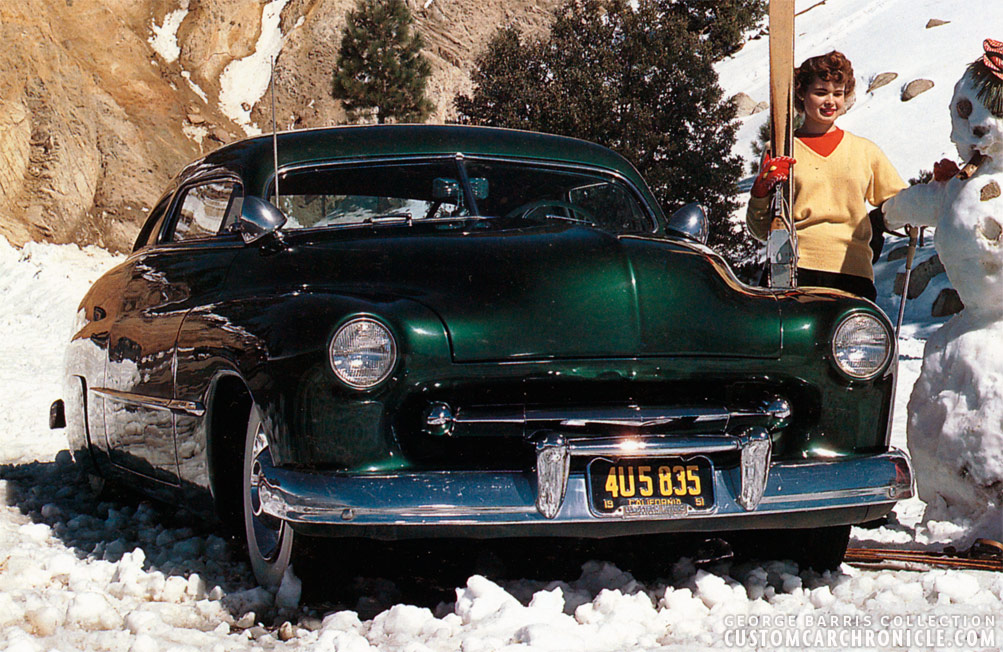 Sam Barris’s personal 1949 Mercury was chopped around the same time as Jerry Quesnel’s. It was finished (sans interior) at the Feb 1951 Oakland Roadster show. The car had straight B-Pillars, shaved drip rails, rounded door top corners and a molded grille shell, but the hood and trunk corners remained stock.
Sam Barris’s personal 1949 Mercury was chopped around the same time as Jerry Quesnel’s. It was finished (sans interior) at the Feb 1951 Oakland Roadster show. The car had straight B-Pillars, shaved drip rails, rounded door top corners and a molded grille shell, but the hood and trunk corners remained stock.
[divider]
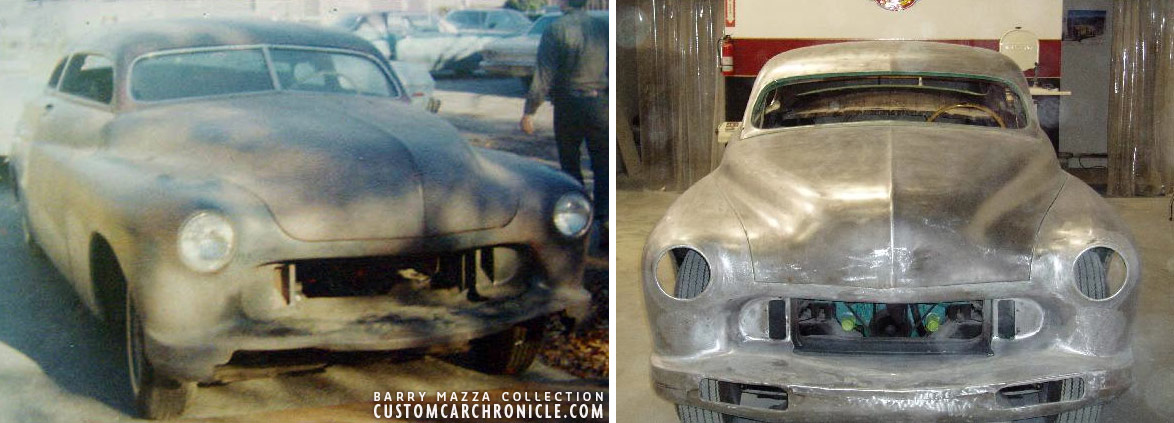 A later owner of the Sam Barris Mercury decided to add rounded corners to the hood… and those were brought back to stock specs during the complete restoration at the Brizio shop for new owner John Mumford.
A later owner of the Sam Barris Mercury decided to add rounded corners to the hood… and those were brought back to stock specs during the complete restoration at the Brizio shop for new owner John Mumford.
[divider]
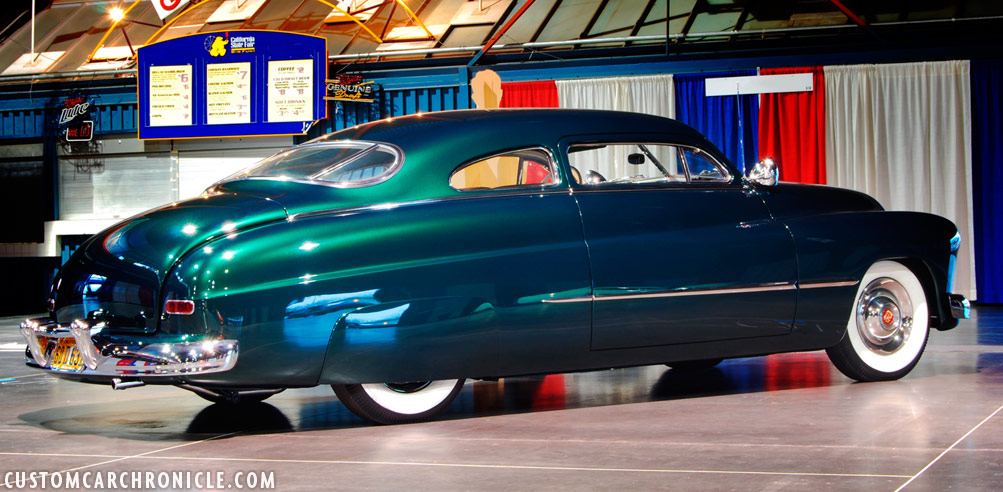 The restored Sam Barris Mercury at the 2009 Mercury Gathering at the Sacramento Autorama. Rounded door tops, square trunk corners.
The restored Sam Barris Mercury at the 2009 Mercury Gathering at the Sacramento Autorama. Rounded door tops, square trunk corners.
[divider]
Louis Bettancourt Mercury
One of the most impressive cases of rounding corners must be on the Ayala built Louis Bettancourt 1949 Mercury. We are not sure when the Ayala’s started the work on the car and performed all the molded in and rounded corners. But the car debut at the 1952 Motorama show. More than likely the car was already started around 1950-51. The whole car was molded, and all the seams were welded and filled in, even the beltline and the window surrounds were molded in. Any sharp edge, or corner on this car would have looked so much out of place, so the Ayala’s rounded all the corners on it.
They decided to use a very large radius for all the corners. Very unique on this car is the way the rear hood and top trunk corners are rounded. By using the large and flowing radius here, the new lines help with the flow of the chopped top. It makes the eye flow much easier from the lower body into the roof. At the rear this rounded corner help integrate the rear window better.
 Louis Bettancourt Mercury finished in lime gold by the Ayala’s. Notice how every panel was welded and molded in, no sharp edge to be detected. Everything flows together, looks clean and smooth. Even the bottom rear door corders were rounded.
Louis Bettancourt Mercury finished in lime gold by the Ayala’s. Notice how every panel was welded and molded in, no sharp edge to be detected. Everything flows together, looks clean and smooth. Even the bottom rear door corders were rounded.
[divider]
 Popular Mechanics April 1953 had an article about Customizing cars and showed this Louis Bettancourt’s ’49 Mercury with explaining words what had been done to the car. Apparently it was not completely clear to the lay-out artist what all corners rounded meant.
Popular Mechanics April 1953 had an article about Customizing cars and showed this Louis Bettancourt’s ’49 Mercury with explaining words what had been done to the car. Apparently it was not completely clear to the lay-out artist what all corners rounded meant.
[divider]
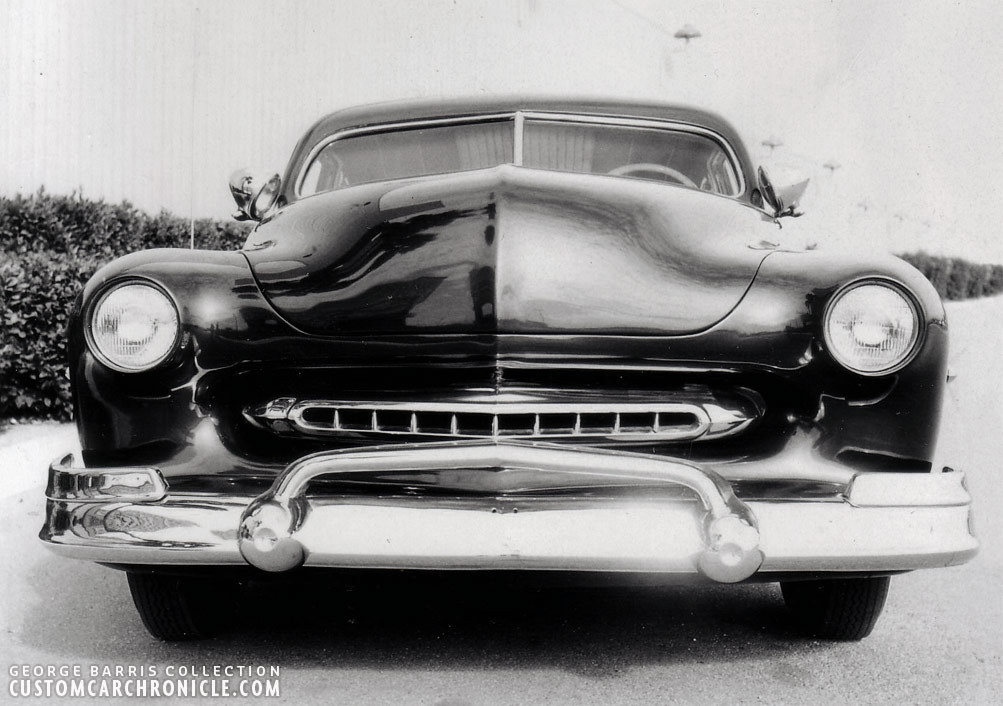 This front photo of the later Barris version of the Bettancourt Mercury shows the large radius of the front hood corners and how well they flow with the grille opening, the fender shape and headlights. Custom Merc perfection.
This front photo of the later Barris version of the Bettancourt Mercury shows the large radius of the front hood corners and how well they flow with the grille opening, the fender shape and headlights. Custom Merc perfection.
[divider]
 The Larry Ernst 1951 Chevy was restyled by the Barris shop in 1951, and even though a 49-50 Mercury grille surround was molded in place, the hood corners remained straight on its first version. Some time after the car was finished and shown the car came back to the shop for a remake. At this time the hood corners were rounded to make the front end flow much better.
The Larry Ernst 1951 Chevy was restyled by the Barris shop in 1951, and even though a 49-50 Mercury grille surround was molded in place, the hood corners remained straight on its first version. Some time after the car was finished and shown the car came back to the shop for a remake. At this time the hood corners were rounded to make the front end flow much better.
[divider]
 George Barris captured the process of rounding the corners on the Larry Ernst Chevy. These photos show that the work was done much nicer than the work done earlier on cars as the Jack Stewart and Snooky Janish Fords. The finished work looked almost factory stock.
George Barris captured the process of rounding the corners on the Larry Ernst Chevy. These photos show that the work was done much nicer than the work done earlier on cars as the Jack Stewart and Snooky Janish Fords. The finished work looked almost factory stock.
[divider]
The Bob Hirohata 1951 Mercury was restyled by the Barris Shop, and somewhat similar to the Ayala restyled Bettancourt Mercury most everything on this car was molded and shaved. Barris took this car a step further by reshaping the side contours and extending the hood and creating a completely new grille opening. To make everything work even better on this car all corners were rounded as well. Barris even rounded all the bottom corners on the doors on this Mercury and might have been the first to do so.
 The new extended lip corners on the hood were rounded and both on the hood and front sheep metal the finishing work was done very well.
The new extended lip corners on the hood were rounded and both on the hood and front sheep metal the finishing work was done very well.
[divider]
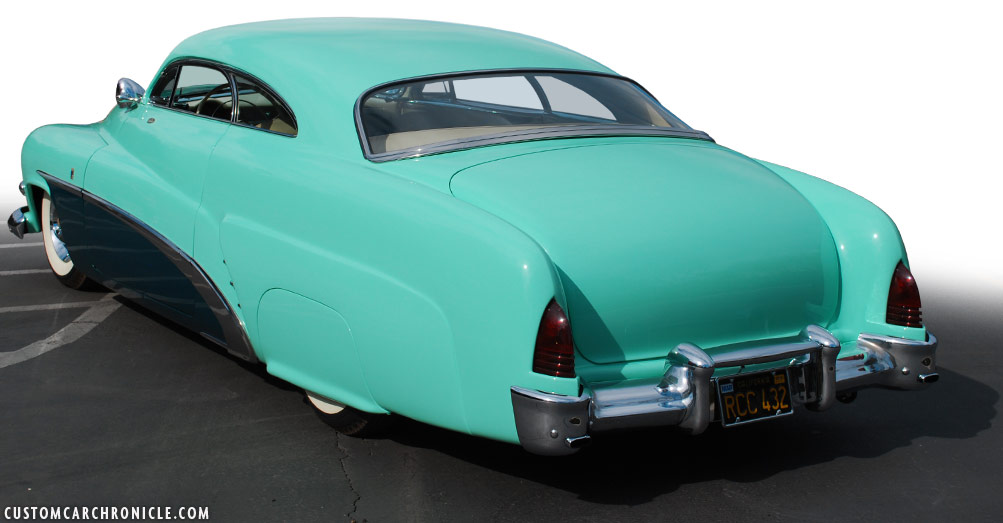 This rear quarter photo shows the large radius of the trunk rounded corners, helping with the flow of the car and make everything look smoother.
This rear quarter photo shows the large radius of the trunk rounded corners, helping with the flow of the car and make everything look smoother.
[divider]
 The work on the trunk corners was done a little less perfect than the hood corners. Possibly somebody else did the work, possibly the deadline of the 1952 Motorama show (for the cars debut) interfered with more fine tuning. Notice how the lip on the top corner was rounded, which was more than on older work the shop did, but the drip rail inside was not altered to follow the new shape.
The work on the trunk corners was done a little less perfect than the hood corners. Possibly somebody else did the work, possibly the deadline of the 1952 Motorama show (for the cars debut) interfered with more fine tuning. Notice how the lip on the top corner was rounded, which was more than on older work the shop did, but the drip rail inside was not altered to follow the new shape.
[divider]
 The Barris price list from around 1953 lists rounding corners for $15.- ea. And 3 hours work.
The Barris price list from around 1953 lists rounding corners for $15.- ea. And 3 hours work.
[divider]
After 1952 rounding corners became more or less the rule on most customs. From mild to wild rounding corners was on of the to do things on the list. The rounding of the corners makes a custom really stand out from the factory car. To be able to round corners it often means that body panels need to be welded solid for that very desirable one piece look. And then any sharp corners would be out of place. We are now so much used to the round corners on Custom Cars, that is sometimes hard to imagine the early cars did not have them, specially when the rage was molding and smoothing everything.
 A really great sample of how much we are used to the rounded corners look on the ’49-51 Mercury is this 1951 Mercury built by Lucky7 Customs for George Garza. Everything on this car flows together beautifully helped by all the rounded corners, and reshaped panel lines. Especially nice is the way the rear hood corners were cut and rounded, and help with the flow of the roof into the lower body. The front edge and corners of the trunk were also completely reshaped to flow with the new roof shape.
A really great sample of how much we are used to the rounded corners look on the ’49-51 Mercury is this 1951 Mercury built by Lucky7 Customs for George Garza. Everything on this car flows together beautifully helped by all the rounded corners, and reshaped panel lines. Especially nice is the way the rear hood corners were cut and rounded, and help with the flow of the roof into the lower body. The front edge and corners of the trunk were also completely reshaped to flow with the new roof shape.
[divider]
 Rob Radcliffe of King Kustoms rounded all the corners on his 1950 Ford Custom. These in progress photos give us a good insight of how great this looks, and how much more detailed these are done than the work done back in the early 1950’s. Perfect panel gaps and rounded corners like these make a car look so good.
Rob Radcliffe of King Kustoms rounded all the corners on his 1950 Ford Custom. These in progress photos give us a good insight of how great this looks, and how much more detailed these are done than the work done back in the early 1950’s. Perfect panel gaps and rounded corners like these make a car look so good.
[divider]
[box_light]
Every time I create another Custom Car history article I realize how many photos of historic custom cars there are that come from the Barris Shop. It is really amazing how many photos George Barris took, requested to take, or collected. And hoe many of those have been shared and published. And how incredibly important this has been for capturing the early days of Customizing. A big thanks to the Barris Shop and George Barris, without them Custom Car history would not have been the same.
[/box_light]
(This article is made possible by)
![]()







Another great article into the origins of one of the customizing details that most just take for granted these days.
The rounded corners on the trunk lids really make a difference.
I love seeing the old price guide ads from the Barris shop as well. I imagine many a teenager dreaming of how they could save the money to have the work done to their car.
And thanks for the aside about George Barris and the Barris shop. With out them and their documentation a huge portion of custom car history would have been lost.
Torchie
Great article, Rik. I think rounded corners are a must on all kustoms- even on un-chopped mild kustoms as they really are a nice detail that sets the car apart. At the very least, rounding corners and molding seams cleans up all of the factory lines that hint to the mass production assembly line look.
I rounded every corner on my ’50 Ford and to do it the right way is not an easy task. When I first saw the trunk corners on the Hirohata, I realized Barris only did the outer skin for cosmetics too…that was surprising to me but I guess it was the norm back then. Perhaps it wasn’t important to redo the entire channel or they didn’t have the time as they cranked out kustoms for shows that had rapidly changing trends. Another thing to consider is the capabilities with the tools they had in the late ’40s and ’50s…must have been really hard to get in there with a 14″ grinder and I doubt it was possible to hand file the little corners rather than just welding an outer skin for the same look.
I will say one reason you don’t see a lot of the front bottom corners rounded on ’49-’51 Mercs is that it is very tricky to do because of the lip on the front edge of the door that tucks behind the front fender. When the door opens, there is a very limited roundness that can be achieved without the door and fender hitting each other.
Another thing about rounding corners is that it demands that the front sheetmetal becomes welded and molded to the body. That was the norm back in the day, but I have encountered customers nowadays who do not want to make that commitment…some like the idea of being able to remove the front clip and others have considered the ease of replacement in the event of a collision. I have my thoughts on it and I think the smooth molded and rounded look always wins out. 🙂
Rik, you should post some more pictures of modern built kustoms with rounded corners.
Another great article Rik. It’s amazing how much the quality of builds has changed over the years. I find it really interesting how “hacked together” some of the stuff was back then but I guess it was young guys building cars on a budget and a time constraint, needing the cars for day to day use, that dictated how some stuff was done. I almost wonder if some of the newer stuff is almost too perfect and loses some of its allure not having some rough edges as it were.
Thanks for the history lesson on a very interesting topic. I really like rounded corners and had a bit of an internal struggle when I did my Buick. Don’t think I ever have seen flipped door handles before, as on the -40 Ford in the article.
Great article. I love rounded corners, and that is something I always look for on Customs. Very interesting to see some examples of it developing in early customs, and photos of how it was done.
Thanks Rik..another great article from you. I have a traditional body myself..all corners are rounded haha..